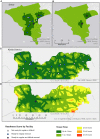Clinical, logistic, and geographic factors in ensuring adequate access to implant removals: A cross-sectional survey of public facilities and GIS modeling of geographic access in two districts of Senegal
- PMID: 36386435
- PMCID: PMC9640762
- DOI: 10.3389/fgwh.2022.899543
Clinical, logistic, and geographic factors in ensuring adequate access to implant removals: A cross-sectional survey of public facilities and GIS modeling of geographic access in two districts of Senegal
Abstract
Introduction: Ensuring adequate access to contraceptive implant removal services requires an understanding of potential clinical, logistical, and geographic challenges.
Methods: We conducted a cross-sectional survey of 39 public health facilities in two districts of Senegal. To assess facility readiness, we reported the proportion of facilities meeting all minimum conditions for regular and difficult implant removals. We then describe characteristics of referral networks. Geographic access modeling was conducted in a geographic information system to estimate the proportion of women of reproductive age living within specific travel times of facilities ready for regular and difficult removals.
Results: 72% of facilities met all conditions for regular removals, and 8% for difficult removals. In both cases, the main gaps related to equipment availability (79% of facilities had the minimum equipment for regular removals and 8% for difficult removals). 72% of facilities organized in three referral networks sent clients to other facilities for cases they could not manage. Of 11 receiving or single-network facilities, seven were ready for regular removals and one for difficult removals. Altogether, 36% of women in Dakar Centre and 99% of women in Kolda lived within two hours of a facility that was equipped to handle regular removals, compared to 15% and 69%, respectively, for difficult removals.
Conclusion: Data such as those provided in this assessment are important to provide a realistic picture of the state of readiness of the health system and its ability to meet the inevitable demand for implant removals. Referral networks should be considered as an emerging strategy to avail sufficient capacity at the systems level, including for managing difficult removals. However, careful thought should be given to the location of facilities that are ready to receive cases in order to target upgrades.
Keywords: Senegal; contraception; contraceptive implant; long-acting reversible contraception (LARC); readiness; referrals; removals; sub-Sahara Africa (SSA).
© 2022 Brunie, Parker, Ndiaye, Sarr Aw, Keyes, Lebetkin, Dioh, MacCarthy and Ndiaye.
Conflict of interest statement
The authors declare that the research was conducted in the absence of any commercial or financial relationships that could be construed as a potential conflict of interest.
Figures
References
-
- United Nations, Department of Economic and Social Affairs, Population Division. World contraceptive use 2020 (POP/DB/CP/Rev2020) (2020).
-
- Ouagadougou Partnership. Senegal data (2021). Available at: https://partenariatouaga.org/en/country/senegal/#
-
- Agence Nationale de la Statistique et de la Démographie - ANSD/Sénégal, ICF. Sénégal: Enquête démographique et de santé continue - EDS-continue 2019. Rockville, Maryland, USA: ANSD et ICF. (2019).
-
- Agence Nationale de la Statistique et de la Démographie - ANSD/Sénégal, ICF International. Enquête démographique et de santé à indicateurs multiples sénégal (EDS-MICS) 2010–2011. Calverton, Maryland, USA: ANSD and ICF International. (2012).
LinkOut - more resources
Full Text Sources
Research Materials
Miscellaneous



